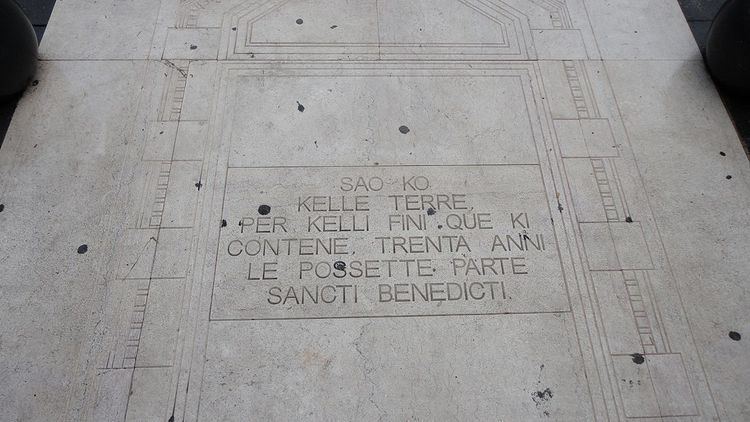Genre Juridical document | Date 960-963 Manuscript(s) 4 | |
 | ||
Subject Resolution of a property dispute | ||
The Placiti Cassinesi are four official juridical documents written between 960 and 963 in southern Italy, regarding a dispute on several lands among three Benedictine monasteries and a local landowner. They are considered the first documents ever written in the Italian language along with the Veronese Riddle.
Contents
Text
Original text:
Sao ke kelle terre, per kelle fini que ki contene, trenta anni le possette parte Sancti Benedicti. Capua, Marzo 960Sao cco kelle terre, per kelle fini que tebe monstrai, Pergoaldi foro, que ki contene, et trenta anni le possette. Sessa, Marzo 963Kella terra, per kelle fini que bobe mostrai, sancte Marie è, et trenta anni la posset parte sancte Marie. Teano, Luglio 963Sao cco kelle terre, per kelle fini que tebe mostrai, trenta anni le possette parte sancte Marie. Teano, Ottobre 963Modern Italian:
So che quelle terre per quei confini che qui sono contenuti le possedette per trent'anni la parte di San Benedetto. Capua, Marzo 960So che quelle terre, per quei confini che ti mostrai, furono di Pergolardo, e qui sono contenuti e per trent'anni li possedette. Sessa, Marzo 963Quella terra per quei confini che a voi mostrai è di Santa Maria e per trent'anni la possedette la parte di Santa Maria. Teano, Luglio 963So che quelle terre per quei confini che ti mostrai per trent'anni le possedette la parte di Santa Maria. Teano, Ottobre 963Translated:
I know those lands, whose borders are shown in the map, have been owned by St. Benedict's region for thirty years. Capua, March 960I know those lands, whose borders I have showed you, were property of Pergolardo, and here are part of, and it has owned them for thirty years. Sessa, March 963That land, whose borders I have showed you, is property of St. Marie, and St. Marie's region has owned it for thirty years. Teano, July 963I know those lands, whose borders I have showed you, have been owned by St. Marie for thirty years. Teano, October 963Explanation
The documents called "placiti" (placito means judge's opinion) are a group of four parchments and were discovered by Erasmo Gattola in the benedectine monastery of Monte Cassino, about 130 kilometres (81 mi) southeast of Rome, in the 1700s. The documents are a resolution of a dispute on the property of several lands located in the Italian cities of Capua, Sessa Aurunca and Teano, between three monasteries owned by Monte Cassino and Rodelgrimo d'Aquino, a local landowner. With these documents, after the deposition of three witnesses, the judge clearly stated that the three monasteries were the legitimate owners of the lands.
